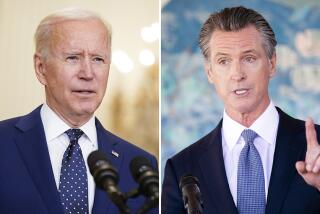What the U.S. could learn from Mexico
IN 1986, I OBSERVED an election in Mexico’s northern state of Chihuahua and learned almost everything I would ever need to know about election fraud. Last week, I observed elections again in Mexico, but this time, I concluded that the United States and the world could learn much from Mexico about how to conduct and judge a free and fair election.
This might come as a shock. After all, the election looked messy from the outside. It took four days before Mexico’s Federal Election Institute, or IFE, announced a winner -- Felipe Calderon, the leader of the conservative National Action Party -- by the slimmest of margins (0.58%, or about 244,000 votes out of 41 million). Calderon did not bother to wait for the announcement to proclaim his triumph, and his main rival, Andres Manuel Lopez Obrador of the leftist Democratic Revolution Party, or PRD, also announced victory and quickly challenged the IFE’s conclusion.
Close elections are always dangerous. Even in long-standing democracies like the U.S., a close election (like in 2000) often leaves the losing party resentful and angry. In new democracies, political suspicions often collide with administrative incapacity during close elections, leading to unrest or violence.
It is too soon to know whether Mexico will avoid these pitfalls. But its chances of doing so are greater because, in the last decade, it has constructed some of the most sophisticated electoral institutions and procedures in the democratic world. I compared the electoral systems of North America, and the good news is that the U.S. came in third. The bad news is that there are only three countries in North America.
It is hard for most Americans to accept that Mexico has overtaken us in electoral administration, but let me count the ways. First, U.S. elections mostly are run by partisan secretaries of state or local officials -- not by the federal government. Mexico has a nonpartisan, fully autonomous national election commission -- the IFE -- whose members must be approved by two-thirds of the legislature. The IFE meetings are open to the political parties but not run by them. On election day, the IFE tracked problems and responded instantly. The IFE is one of Mexico’s most respected institutions.
Second, only one U.S. state allows international observers. The IFE opens all of Mexico to international observers and facilitates access to all stages of the process.
Third, the U.S. has great difficulty recruiting and training election officials. The IFE has 13,000 full-time officials and a professional election service of 2,400. It treats election administration as a civic obligation like jury duty, and in 2006, it randomly selected 7.2 million citizens for training. Of those, it chose the best 913,000 citizens to conduct elections at 130,500 polling stations.
Fourth, U.S. voter registration lists are organized poorly by counties or states with very different ID requirements. Mexico, by contrast, has registered 95% of its citizens, and it audits and updates the list at least every year. Mexico has multiple safeguards to ensure that citizens vote only once, including a list with the photos of all citizens, indelible ink on voters’ thumbs and a state-of-the-art, biometric ID card.
Fifth, massive private funding continues to taint U.S. campaigns. In Mexico, political parties receive most of their funds from the government and get free access to the media. The IFE monitors and regulates campaign contributions and expenditures.
Sixth, in the last elections, the U.S. was distracted by inaccurate, media-run exit polls. The IFE allowed 32 exit polls and party counts, but the IFE’s “quick count” was announced by 11 p.m. on election day, and it was the most accurate (a margin of error of 0.3%). The IFE’s announcement after the quick count that the race was too close to call gave stability for the full count to proceed, and the preliminary results came out one day later.
Finally, the U.S. judicial system is not trained for election disputes. The U.S. Supreme Court ultimately precluded a recount in the 2000 presidential election because it judged that there was not enough time before the Electoral College was supposed to vote. Mexico, meanwhile, created a specialized electoral court, or TRIFE, and has allowed two months to hear and resolve all the electoral challenges, still leaving three more months before inauguration.
Mexico’s electoral system is hardly perfect. Out-of-state voters faced long lines last week and too few ballots at “special polling stations.” There were errors in the local counts. Lopez Obrador has raised issues that must be addressed fully and fairly by the TRIFE for his party to be persuaded that the vote wasn’t stolen, and that may require a complete recount. On Thursday, the IFE’s very competent president announced who had the most votes, but only the TRIFE can certify who is president, and its final deadline is Sept. 6.
Mexico has traveled a great distance toward democracy, but some politicians still think the election should be decided in favor of whoever can bring the most supporters into the streets or that it should be determined by a closed-door political bargain. The question now is whether Mexico will follow its old habits or its new electoral institutions.
Meanwhile, in the United States, the question is whether we will remain satisfied with our partisan, unprofessional system, driven by private contributions and that does not even permit observers, or whether we are prepared to learn from our neighbor.
More to Read
Start your day right
Sign up for Essential California for news, features and recommendations from the L.A. Times and beyond in your inbox six days a week.
You may occasionally receive promotional content from the Los Angeles Times.






